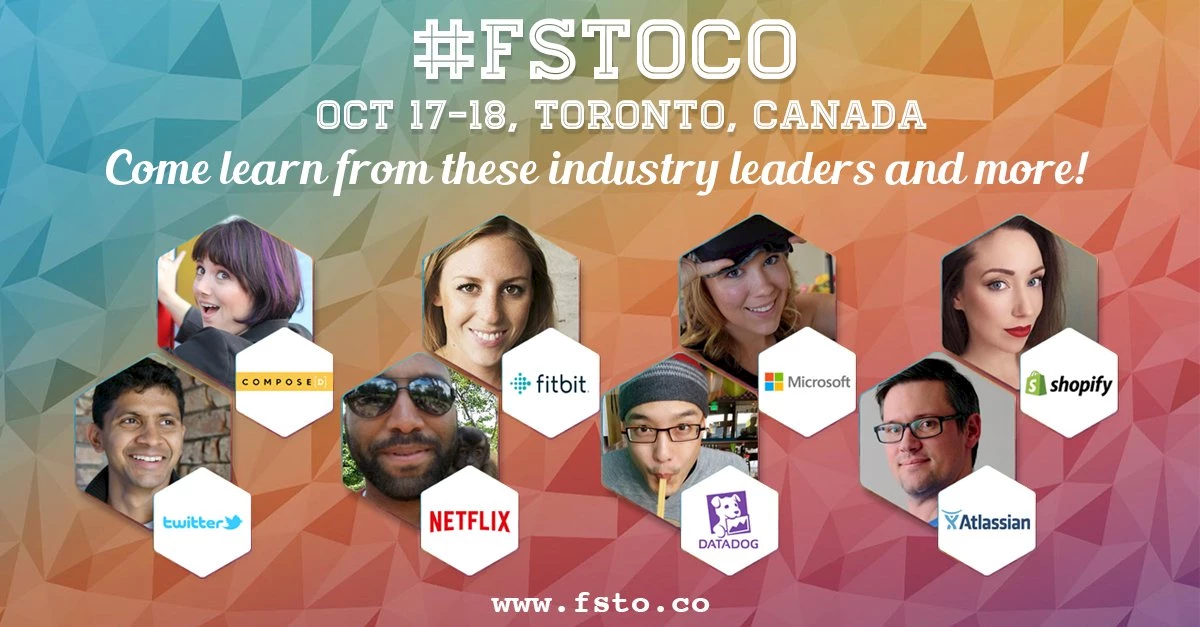
Earlier this week, I attended #fstoco, a Web-oriented conference held in Toronto where I had the privilege of making a presentation. This event is organized by Full Stack Toronto, a non-profit organization. The conference covers a wide range of subjects, including front-end development, back-end development, UX, project management and dev ops. If you haven’t yet attended #fstoco, you should really look it up soon, as they sold out all 400 tickets this year.
The event was held at the Sheraton Center this year. This is a great venue located right in downtown Toronto, making it easy for attendees to gather after the event for post-conference networking.
In my opinion, the pace of the conference was great, with 40-minute talks followed by a 20-minute break each hour. This gave attendees plenty of time to let the information sink in and to share their knowledge with others during the breaks.
The conference had 6 different tracks:
- Front-end development
- Back-end development
- Dev ops
- User experience
- Project management
- Product development
For a total of 34 different presentations spread over two days.
I attended many presentations on various subjects and they were all very interesting. Here are some of the trends that I’ve noticed.
Diversity
The conference organizers took this issue very seriously, as demonstrated by the speaker lineup, which proudly stated that 18 out of the 34 speakers identified themselves as a member of an underrepresented community. The venue was also appropriate for this, with non-binary washrooms and dedicated zones for nursing, wellness and spiritual activities. The opening keynote (“The Radical Topic of Women in Tech” by Marissa Levy Lever) was about the place of women in technology. Ms. Levy Lever not only encouraged women to claim their place in the tech industry but also gave us stats about the success of organizations with diversified teams.
Front-End
Based on the talks that I attended, it seems like the most popular JavaScript framework nowadays is React (“How to Build a React Native Game in 72 days” by Brandy M. Bergh, and “If you’re reading .then(), it’s too late” by Luke Westby). Also, most of the unconference discussions seemed to be more oriented towards React than any other front-end framework.
Back-End
I don’t usually attend a lot of back-end talks, but I was curious about the presentation by Amber Houle, titled “Leave your ‘cruddy’ app behind: Exploring Alternatives to CRUD web apps with CQRS and Event Sourcing”. During her talk, Ms. Houle gave us a quick introduction to CQRS as an alternative to CRUD for larger applications. CQRS seems especially well suited for large applications that require heavy logging like those in the financial or healthcare industries. I will definitely look into it for our next project in this field.
About Those Things
I’m always interested in the IoT talks. I find the integration of the physical world using our regular Web browser exciting. This was well captured in the talk by Dan Jenkins about “Getting Physical with Web Bluetooth in the Browser”, in which he demonstrated how to use Chrome on your mobile device to control devices like a drone or a BB8. This is something I will certainly put to work in some of my personal projects. I unfortunately was not able to attend the talk “Why You Should Care About the Virtual Reality Web” by Liv Erickson but there has definitely been more and more traction around VR and augmented reality lately (see our latest “Techtoberfest” event.
In Summary
Overall, I believe this conference was a great success. I got to meet a lot of new people and got a lot of new knowledge out of it. As a speaker, I found the organization committee took great care of us by showing us around the city and organizing ad hoc events after hours. It’s definitely a conference that I would recommend speaking at.

